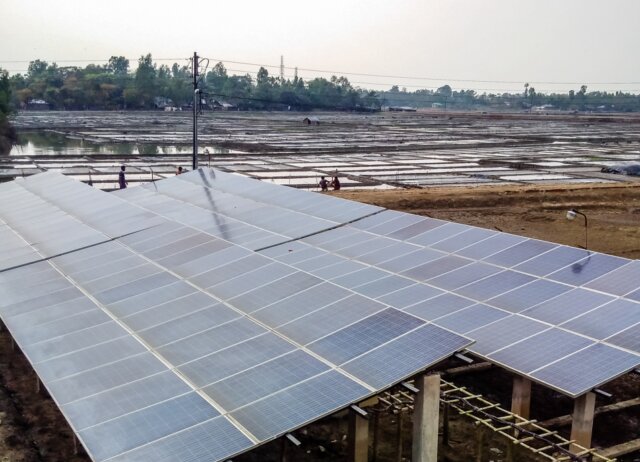An enlightening reporting trip reveals the promise of solar microgrid plants
In rural Bangladesh, people have been relying on basic and unreliable electricity from solar home systems (SHS). So reporter Faisal Mahmud was thrilled to learn about solar microgrid power plants, a new alternative which provides constant access to energy

My home district of Narshingdi is just 60 kilometres away from the capital city of Dhaka. I am a lifelong Dhaka-dweller, but I go to Dhanua, my village in Narshingdi, to get the taste of country life every now and then.
We have a gas connection in our village home. But even in many parts of Dhaka, people can’t access a gas line and are forced to use a liquefied petroleum gas (LPG) cylinder for cooking.
I never knew that in Narshingdi, which is full of different industries, there are still places where the national grid has yet to reach and the people in these areas are deprived of continuous electricity.
In October of last year, I became aware of that fact after I went to visit a remote ‘char’ (an island in a river, formed with sediment) in Narshingdi with PR company Cool Exposure. I went there to visit the largest solar microgrid power plant (capacity 147 kW) in the country.
At that time, I also didn’t have a clear idea about what a solar microgrid power plant was. As a journalist who has been covering the energy and power beat for some time, my lack of knowledge on that issue is inexcusable.
But the thing is, solar microgrid power plants are a relatively new concept in Bangladesh and, most importantly, the mainstream media has paid almost no attention to their success.
So it was a tour of enlightenment for me. During that visit, I had observed how solar microgrid power plants changed the lives of people living there. Solar home systems (SHS) have long been a popular choice in the remote countryside where the national grid hasn’t extended, but I was never overwhelmed about their success.
I soon discovered that the solar microgrid power plants, unlike SHS, provided underserved people with 24/7 electricity.
So, when I learned about Discourse Media's Access to Energy Journalism Fellowship, which provided the opportunity to produce in-depth reporting on energy access, I immediately pitched the idea of doing a story on the potential of solar microgrid power plants in Bangladesh.
After getting the fellowship and doing some research in Dhaka, where all the ministries, organizations and companies working in the solar microgrid power plant sector are located, I decided to go to Sandwip and Kutubdia, two remote islands in the Bay of Bengal, to do my field work.
There are seven operational solar microgrid power plants in the country (with 11 more in the pipeline now), but I chose those two for specific reasons. I selected Sandwip because the pilot solar microgrid power plant project started there. I chose Kutubdia because they used a smart metering and smart card system, which I wanted to see in operation.
Besides, I had always read about those two islands in geography books during my school years, but never visited. But people warned me that the journey to those places is hectic.
Visiting these islands was indeed hectic, as I later discovered. I went to Chittagong, the port city, from Dhaka. There I took a bus to reach Kumira Ghat. Kumira Ghat has some trawlers and speed boats to go to Sandwip, but because of the scarcity of both transports, I had to wait for hours to catch a speed boat.
The weather was gloomy and marked by intermittent rains. Some of the boat services were stopped because of the weather. I was able to reach my destination and finish my field work within my fixed schedule.
The next day, I went back to Chittagong and from there I took another bus to Chokoria, Cox’s Bazaar. From Chokoria, the journey to Mognama Ghat is usually done by local three-wheelers or small buses known as ‘murir tin’ (which is a tin of puffed rice: people are stuffed inside as though in a tin of puffed rice).
I took a three-wheeler. The roads were dilapidated and after the two-hour journey, I felt like my bones had been displaced. From Mognama Ghat, I took a speed boat ride to reach Kutubdia.
When I first stepped onto Kutubdia, the first thing that came to my mind was how beautiful the island was. I took an engine rickshaw to reach almost the other end of the island where the solar plant was located. The journey was a scenic one amidst the salt pans. The whole island of Kutubdia is full of those.
On both of the islands, I found the solar microgrid power plants to be a success. People have long been familiar with solar power here, where it has brought limited light to their households. But they never had electricity during the daytime, as SHS are used only at night.
The residents also didn’t know electricity could be available 24/7, because the costly and unreliable diesel generators that provide power to the marketplace and some houses were functional at most for about eight hours a day.
Solar microgrid power plants work like magic for people on those two islands. They want more plants because they believe more electricity will change their lives.
